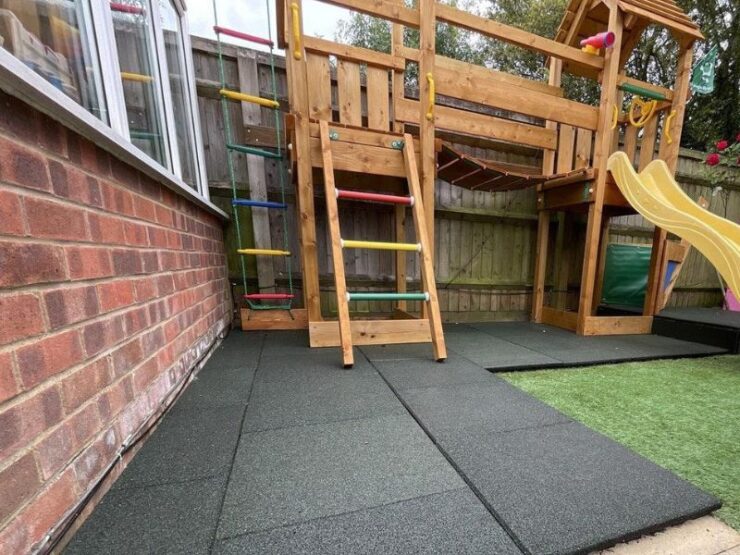A playground should feel like an open invitation to move, explore, and have fun. Every child deserves a space that works for them, no matter their ability, mobility, or sensory needs.
That means thinking beyond slides and swings. It means creating a space that allows everyone to be part of the action safely and comfortably.
Key Points
- Safety should be the foundation of every playground layout and material choice.
- Accessibility must be prioritized with ramps, pathways, and varied activity options.
- Sensory-friendly elements support children with different sensory needs.
- Equipment should be adaptable and encourage social interaction.
- Playground flooring mats provide impact absorption and improve overall safety.
- Inclusive play areas should offer different types of movement, exploration, and social engagement.
- Budget-friendly adjustments can make a big difference in accessibility.
- Proper maintenance keeps the space safe and welcoming.
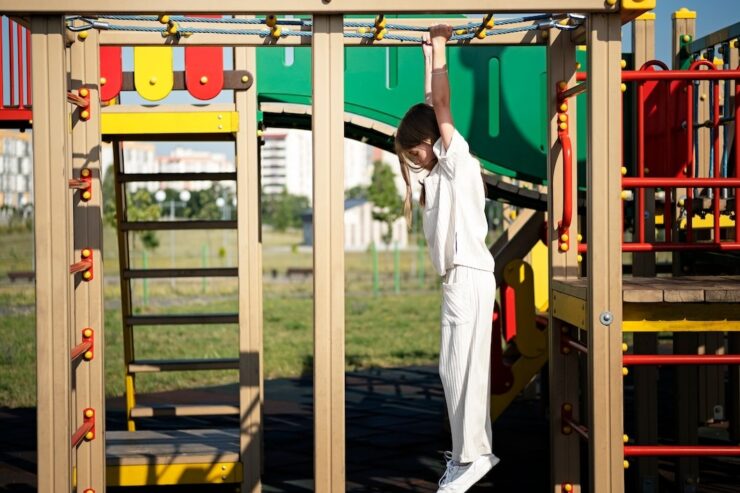
Start with Safety: No Excuses
Every outdoor play space must focus on safety first. Nothing matters more than reducing risks while keeping the fun factor high.
Many injuries happen because of hard surfaces, poor layouts, or broken equipment.
Parents, teachers, and planners must take responsibility for creating an environment that lowers those risks.
Hard surfaces like asphalt and concrete belong in roads, not play areas. Falls happen, but they should not lead to serious injuries.
Proper surfaces reduce the impact of falls, helping children stay safe.
Playground flooring mats provide excellent shock absorption and work for different budgets.
Rubber, synthetic turf, or engineered wood fiber offer options that help protect children during active play.
Other safety concerns involve the layout and equipment. Designers must think about:
- Rounded edges instead of sharp corners to avoid unnecessary injuries.
- Good drainage systems that prevent slippery conditions after rain.
- Proper spacing between equipment to allow free movement without collisions.
- Supervision-friendly layouts so adults can keep an eye on children at all times.
A safe space never comes together by accident.
Every decision must factor in how children move, interact, and occasionally take risks.
Smart choices keep injuries to a minimum and allow every child to explore with confidence.
Accessibility: More Than Just a Ramp
Many assume that adding a single ramp makes a space accessible.
That assumption leads to frustration for children with mobility challenges.
An inclusive design requires thoughtful planning so that every child has a way to enjoy the space equally.
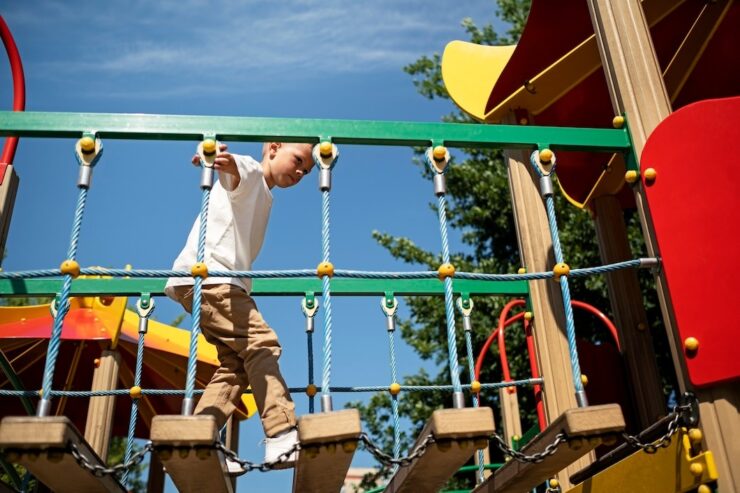
Wheelchairs, strollers, and other mobility aids need wide, smooth pathways that provide enough space to maneuver.
Cracked or uneven surfaces create obstacles that stop some children from reaching play structures.
Ramps help, but without level landings or handrails, they do not serve all children well.
Key accessibility features should include:
- Transfer platforms so children can easily move between surfaces and equipment.
- Adaptive swings with additional support and safety harnesses.
- Tactile elements like textured pathways and braille panels for visually impaired children.
- Sensory-friendly stations that engage children who may not use traditional play structures.
An accessible space allows every child to move freely.
That means entry points, seating areas, and interactive features must work for all.
No child should feel limited by their environment.
A well-planned space gives everyone an equal chance to play, interact, and explore.
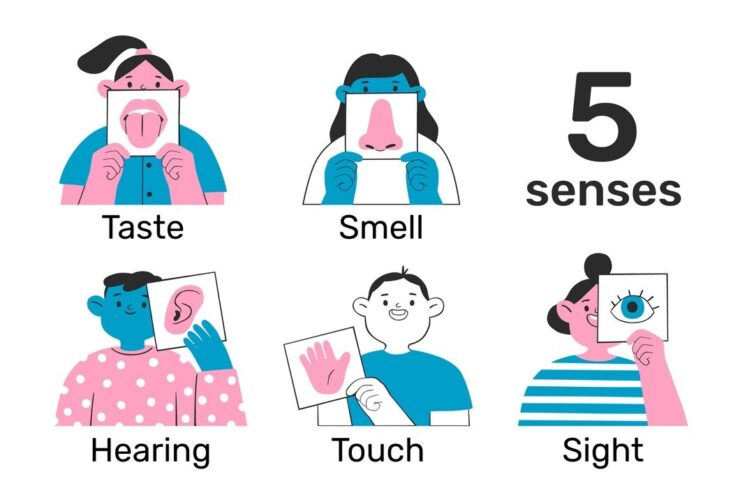
Sensory-Friendly Features for Different Needs
Some children seek movement and noise, while others feel overwhelmed by too much activity.
A well-rounded space includes elements that fit both needs.
Sensory-friendly designs support children with autism, ADHD, and other sensory processing differences.
Not every child enjoys the same type of play. Some look for spinning, rocking, or climbing activities to help with focus.
Others need calming spaces to regulate overstimulation. Providing both options keeps the space welcoming for all.
Effective sensory-friendly features include:
- Quiet zones with shaded seating or enclosed areas for children who need breaks.
- Textured paths and walls to engage different senses through touch.
- Musical elements like drums, bells, or chimes to encourage creative interaction.
- Swings and motion-based equipment for children who seek constant movement.
Children should never feel excluded because a space lacks variety.
Some need high-energy outlets, while others prefer calm interactions. A well-thought-out space ensures every child finds something that suits their needs.
Encouraging Social Play for All
Playgrounds help children build friendships. Social interaction should happen naturally through equipment choices.
If structures force children to compete instead of cooperate, some will feel left out. The best designs encourage connection and teamwork.
Children engage more when equipment allows shared experiences. Side-by-side slides, group swings, and multi-user play panels encourage interaction.
When a space includes only solo activities, some children may struggle to join in.
Ideal features that support social play:
- Group swings so multiple children can swing together.
- Seated merry-go-rounds that accommodate different abilities.
- Parallel play areas where children can engage in similar activities next to each other.
- Multi-height activity stations so children of all ages and abilities can participate.
Social engagement plays a huge role in childhood development. The right features help children form friendships, learn cooperation, and build confidence.
Play should never feel isolating. The best spaces promote shared experiences that welcome everyone.
Budget-Friendly Adjustments That Make a Big Impact
Not every city or school has the budget for a full-scale redesign, but small upgrades can make a big difference.
Sometimes, the right modifications cost little but improve accessibility and safety dramatically.
Affordable changes that enhance inclusivity:
- Adding sensory paths with affordable textured materials.
- Using paint to create games on the ground that do not require extra equipment.
- Installing portable ramps instead of rebuilding entire structures.
- Adding seating with backrests for children who need extra support.
Small investments can change how children experience a space. Prioritizing thoughtful upgrades ensures a welcoming environment without massive costs.
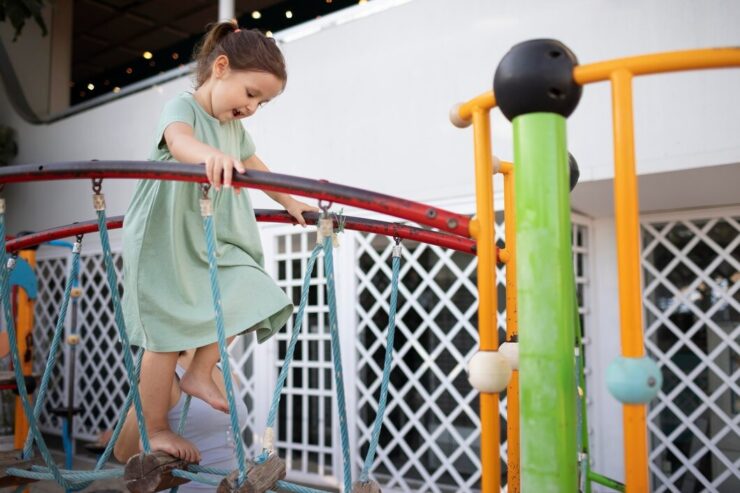
Regular Maintenance: Keeping the Space Safe and Functional
Even the best designs mean nothing without regular upkeep. Equipment wears down. Surfaces shift.
Weather takes a toll. If maintenance falls behind, safety and accessibility suffer.
Routine inspections prevent minor issues from becoming hazards. Regular checks help catch problems before they lead to injuries.
Missing bolts, damaged surfaces, or unstable structures create serious risks. Play areas must remain in top condition year-round.
Essential maintenance tasks include:
- Inspecting surfaces to ensure soft materials stay in place.
- Checking bolts, handrails, and support structures for stability.
- Clearing debris from paths and play areas.
- Fixing broken equipment before it becomes dangerous.
Safe spaces require consistent attention. A playground that receives regular care stays inviting, functional, and ready for all children to enjoy.
Final Thoughts
A great play area includes everyone, no exceptions. With the right flooring, adaptive equipment, and thoughtful layout, every child can have a space that welcomes them.
Safety, accessibility, sensory support, and social interaction should be at the heart of every design choice.
Even small changes can make a huge difference in making the space more inclusive.
Start with the basics, add thoughtful details, and create a place where every child feels excited to play.

